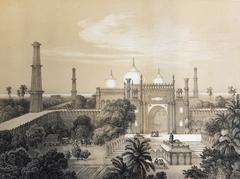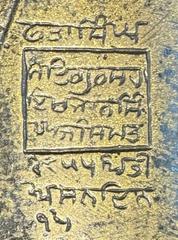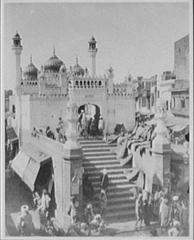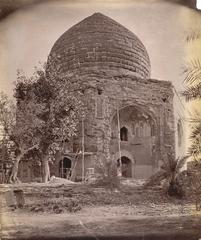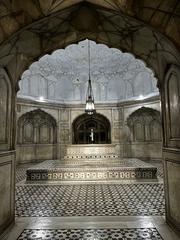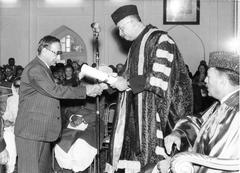Comprehensive Guide to Visiting Bab-e-Pakistan, Lahore, Pakistan
Published Date: 24/07/2024
Introduction to Bab-e-Pakistan
Bab-e-Pakistan, translating to the ‘Gateway of Pakistan,’ is an emblematic monument situated in Lahore, Pakistan. This national monument was conceptualized in 1985 by President General Muhammad Zia-ul-Haq to honor the sacrifices of those who migrated to Pakistan during the partition of India in 1947 (Wikipedia). Designed by Lahore-based architect Amjad Mukhtar, the monument spans 117 acres and includes a memorial block, library, park, museum, auditorium, and art gallery (Graana). The site, located on Walton Road, was one of the major refugee camps following Pakistan’s independence. This complex not only serves as a tribute to the past but also aims to foster a sense of national unity and patriotism among its visitors (BEPF).
Table of Contents
- Bab-e-Pakistan - Visiting Hours, Tickets, History & Cultural Significance in Lahore
- Visitor Guide - Bab-e-Pakistan in Lahore - Hours, Tickets, and Tips
- Top Historical Sites and Attractions to Visit in Lahore
- Introduction
- Lahore Fort
- Badshahi Mosque
- Shalimar Gardens
- Minar-e-Pakistan
- Wazir Khan Mosque
- Lahore Museum
- Anarkali Bazaar
- Wagah Border
- Data Darbar
- Jilani Park
- Lahore Zoo
- Tomb of Jahangir
- Fort Road Food Street
- Greater Iqbal Park
- Allama Iqbal International Airport
- Masjid Wazir Khan
- Jallo Park
- Delhi Gate
- Liberty Market
- Tomb of Allama Iqbal
- Taxali Gate
- FAQ
- Conclusion
Bab-e-Pakistan - Visiting Hours, Tickets, History & Cultural Significance in Lahore
Conceptualization and Approval
The idea of Bab-e-Pakistan, which translates to “Gateway of Pakistan,” was first conceived in 1985 by the then President of Pakistan, General Muhammad Zia-ul-Haq. During a meeting with Lt. Gen. Ghulam Jillani, the Governor of Punjab, the concept was discussed and subsequently approved. The primary objective was to create a national monument that would commemorate the sacrifices of those who migrated to Pakistan during the partition of India in 1947 (Wikipedia).
Design and Architectural Vision
The design of Bab-e-Pakistan was entrusted to Amjad Mukhtar, a Lahore-based architect and a graduate of the National College of Arts, Lahore. The monument is planned to cover an area of 117 acres and will include a memorial block, library, park, museum, auditorium, and art gallery (Graana). The architectural vision aims to blend modern design elements with traditional motifs, creating a space that is both reflective and educational.
Historical Context
Bab-e-Pakistan is being constructed on the site of one of the major Muslim refugee camps that operated in the aftermath of the independence of Pakistan. This site, located on Walton Road in Lahore, served as the first home under the open sky for hundreds of thousands of refugees who migrated to Pakistan in 1947. The monument aims to commemorate the mass migration of Muslims from India to the newly created nation-state and to pay tribute to the millions who sacrificed everything for the cause of Pakistan (BEPF).
Foundation and Delays
The Bab-e-Pakistan Trust was established in 1991 under the Societies Registration Act, 1860, with the objective of setting up a complex to honor those who perished during the migration. The chosen site, encompassing approximately 117 acres, was handed over to the trust in 2005. However, due to various unavoidable circumstances, the project faced significant delays. The initial cost was estimated at Rs 2447 million, and the project was scheduled for completion by March 31, 2012, but it could not be completed within the stipulated time (BEPF).
Transition to Bab-e-Pakistan Foundation
In 2014, the Bab-e-Pakistan Foundation was created through the promulgation of the Bab-e-Pakistan Foundation Act to take over the project and fill the administrative vacuum caused by the death of the majority of the members of the National Supreme Council of the Trust. This transition aimed to ensure the project’s completion and to maintain the monument once it was finished (Graana).
Components of the Monument
The Bab-e-Pakistan complex is designed to include several key components:
- Memorial Block: This will serve as the central feature of the monument, honoring the sacrifices of the refugees.
- Library: A digital library equipped with cutting-edge technology to provide easy access to a vast collection of online resources, along with a reference book library housing a wide range of books and publications related to Pakistan’s history, culture, and literature.
- Museum: The museum will house artifacts and exhibits that tell the story of the partition and the creation of Pakistan.
- Auditorium and Art Gallery: These spaces will be used for cultural and educational events, promoting arts, crafts, culture, language, and literary activities.
- Park: A landscaped park will provide a serene environment for visitors to reflect on the historical significance of the site (BEPF).
Visitor Information
- Visiting Hours: Bab-e-Pakistan is open to visitors from 9:00 AM to 6:00 PM daily. Special guided tours are available on weekends.
- Tickets: The entrance fee is Rs 100 for adults and Rs 50 for children. Students with valid ID cards receive a 50% discount, and entry is free for senior citizens.
- Travel Tips: It’s recommended to visit during the cooler months from October to March. Public transportation options include buses and taxis, and ample parking is available for private vehicles.
- Nearby Attractions: Other historical sites in Lahore include the Lahore Fort, Badshahi Mosque, and Shalimar Gardens, all within a short drive from Bab-e-Pakistan.
- Accessibility: The site is wheelchair accessible, with ramps and designated parking spots for visitors with disabilities.
Significance and Cultural Impact
Bab-e-Pakistan stands as a tribute to those who sacrificed their present for the future of Pakistan. It serves as a symbol of national unity, reminding visitors of the resilience, courage, and determination of the people who fought for the establishment of Pakistan. The foundation is actively involved in the promotion of Pakistan’s ideology, aiming to foster a deep sense of patriotism and national unity among the people (Graana).
Challenges and Future Prospects
Despite the noble intentions and grand vision, the Bab-e-Pakistan project has faced numerous challenges, including bureaucratic delays, funding issues, and administrative hurdles. As of now, the project remains incomplete, but efforts are ongoing to ensure its completion. Once finished, Bab-e-Pakistan is expected to become a major cultural and historical landmark in Lahore, attracting visitors from all over the world and serving as an educational resource for future generations (Nation).
Visitor Experience
Visitors to Bab-e-Pakistan can expect a comprehensive and immersive experience. The monument will offer a blend of historical education and cultural enrichment, with various facilities designed to engage and inform. The digital library and museum will provide valuable resources for researchers and scholars, while the park and auditorium will host cultural events and activities. The art gallery will showcase works that reflect Pakistan’s rich artistic heritage, making Bab-e-Pakistan a hub for cultural and intellectual exchange (TripHobo).
FAQ
- What are the visiting hours for Bab-e-Pakistan? Bab-e-Pakistan is open daily from 9:00 AM to 6:00 PM.
- How do I buy tickets for Bab-e-Pakistan? Tickets can be purchased at the entrance. Adult tickets are Rs 100, children’s tickets are Rs 50, and students with valid ID cards receive a 50% discount. Entry is free for senior citizens.
- What are some nearby historical sites in Lahore? Nearby attractions include the Lahore Fort, Badshahi Mosque, and Shalimar Gardens.
Call to Action
To stay updated on the latest developments and events at Bab-e-Pakistan, download the mobile app Audiala, check out other related posts, and follow us on social media.
Visitor Guide - Bab-e-Pakistan in Lahore - Hours, Tickets, and Tips
Introduction
Bab-e-Pakistan is a monument located in Lahore, commemorating the sacrifices of those who migrated to Pakistan in 1947. This guide will provide you with all the necessary information to plan your visit, including visiting hours, ticket prices, travel tips, and nearby attractions.
History and Cultural Significance
Bab-e-Pakistan stands as a testament to the struggles and sacrifices made during the creation of Pakistan. The monument not only honors the migrants but also serves as a symbol of the country’s rich cultural heritage.
Visitor Information
Visiting Hours and Accessibility
Bab-e-Pakistan is accessible 24 hours a day, making it convenient for visitors to plan their visit at any time that suits them (TripHobo). The monument is located off Walton Road, which is easily reachable by both road and train. For those driving, ample parking space is available near the site.
Entry Fees
Currently, there is no entry fee to visit Bab-e-Pakistan. This makes it an attractive destination for both locals and tourists who wish to explore the historical significance of the site without any financial burden (TripHobo).
Best Time to Visit
The best time to visit Lahore, and consequently Bab-e-Pakistan, is during the winter months from October to February. The weather during this period is pleasant and suitable for outdoor activities (Tourist Secrets). Visiting during these months will allow you to comfortably explore the monument and its surroundings.
Guided Tours
While there are no official guided tours specifically for Bab-e-Pakistan, visitors can benefit from hiring local guides who are knowledgeable about the history and significance of the site. These guides can provide in-depth information and context, enhancing the overall experience.
Facilities
Memorial Block and Museum
The Bab-e-Pakistan complex includes a memorial block and a museum that commemorates the sacrifices of those who migrated to Pakistan in 1947. The museum houses various artifacts, photographs, and documents that provide a detailed account of the migration and the establishment of Pakistan (Graana).
Library and Digital Resources
A library within the complex offers a vast collection of books and publications related to Pakistan’s history, culture, and literature. Additionally, a digital library equipped with cutting-edge technology provides easy access to online resources, making it a valuable resource for researchers and scholars (Graana).
Auditorium and Art Gallery
The auditorium within the Bab-e-Pakistan complex is designed to host various cultural and educational events. It is equipped with modern facilities to accommodate a large audience. The art gallery showcases works of art that reflect the cultural heritage and history of Pakistan, providing visitors with a deeper understanding of the country’s artistic traditions (Graana).
Park and Recreational Areas
The complex also includes a park that offers a serene environment for visitors to relax and unwind. The park is well-maintained and features walking paths, benches, and green spaces, making it an ideal spot for families and individuals looking to spend some quiet time outdoors (Graana).
Travel Tips
Safety and Security
Lahore is generally considered safe for tourists, but it is always advisable to take necessary precautions. Avoid traveling alone at night and keep your valuables secure. The area around Bab-e-Pakistan is well-patrolled, and there is a visible security presence to ensure the safety of visitors (Tourist Secrets).
Cultural Etiquette
When visiting Bab-e-Pakistan, it is important to dress modestly, especially if you plan to visit other religious sites nearby. Removing your shoes before entering someone’s home or a religious site is also considered polite. Engaging with locals respectfully and understanding their customs will enhance your visit (Tourist Secrets).
Dining Options
While there are no dining facilities within the Bab-e-Pakistan complex, several restaurants and food stalls are located nearby. Visitors can enjoy a variety of local and international cuisines. For a more immersive experience, try the local street food, which is known for its rich flavors and variety (Day Times).
Transportation
Bab-e-Pakistan is easily accessible by car, and most visitors prefer to drive to the site. Public transportation options, including buses and rickshaws, are also available. For those traveling from other parts of Lahore, the site is well-connected by major roads, making it convenient to reach (TripHobo).
Photography
Photography is allowed at Bab-e-Pakistan, and visitors are encouraged to capture the monument and its surroundings. However, it is advisable to be respectful and avoid taking photos of people without their permission. The site offers numerous picturesque spots, making it a great place for photography enthusiasts.
Nearby Attractions
Lahore Fort
Located a short drive from Bab-e-Pakistan, Lahore Fort is a UNESCO World Heritage Site and one of the most significant historical landmarks in the city. Visitors can explore its stunning architecture, intricate frescoes, and the iconic Sheesh Mahal (Laure Wanders).
Badshahi Mosque
Adjacent to Lahore Fort, the Badshahi Mosque is one of the largest mosques in the world. Its marble domes, intricate calligraphy, and serene courtyard make it a must-visit for anyone interested in Mughal architecture (Laure Wanders).
Shalimar Gardens
A UNESCO World Heritage Site, Shalimar Gardens is another nearby attraction that visitors should not miss. The gardens are a perfect example of Mughal landscaping and architecture, featuring terraced lawns, fountains, and marble pavilions (Anna Sherchand).
Conclusion
By following these tips and making use of the available facilities, visitors can have a memorable and enriching experience at Bab-e-Pakistan. The monument not only serves as a tribute to the sacrifices made during the creation of Pakistan but also as a symbol of the country’s rich cultural heritage.
FAQ
- Q: What are the visiting hours for Bab-e-Pakistan?
- A: Bab-e-Pakistan is accessible 24 hours a day.
- Q: Isthere an entry fee for Bab-e-Pakistan?
- A: No, there is currently no entry fee to visit Bab-e-Pakistan.
- Q: What is the best time to visit Bab-e-Pakistan?
- A: The best time to visit is during the winter months from October to February.
- Q: Are there guided tours available at Bab-e-Pakistan?
- A: While there are no official guided tours, local guides can be hired to provide in-depth information about the site.
- Q: How can I reach Bab-e-Pakistan?
- A: The site is easily accessible by car, public transportation, including buses and rickshaws, and is well-connected by major roads in Lahore.
Call to Action
For more travel tips and guides, download our mobile app Audiala, check out other related posts, or follow us on social media for more updates.
Top Historical Sites and Attractions to Visit in Lahore
Introduction
Lahore, the cultural capital of Pakistan, is a city steeped in history and rich in architectural marvels. From grand forts and magnificent mosques to lush gardens and vibrant bazaars, Lahore offers a plethora of attractions for history enthusiasts and casual visitors alike. This guide will take you through some of the most iconic landmarks and provide essential visitor information, including visiting hours, ticket prices, and travel tips.
Lahore Fort
History and Significance
Lahore Fort, also known as Shahi Qila, is a UNESCO World Heritage Site and one of the most significant historical landmarks in Lahore. The fort’s current structure dates back to 1566, although it has been rebuilt and modified several times over the centuries. Key highlights within the fort include the Alamgiri Gate, Sheesh Mahal (Palace of Mirrors), and Naulakha Pavilion. The fort’s architecture showcases the grandeur of the Mughal era, making it a must-visit for history enthusiasts.
Visiting Hours and Tickets
- Visiting Hours: 8:30 AM - 5:00 PM
- Tickets: PKR 20 for locals, PKR 500 for foreigners
Badshahi Mosque
History and Significance
Adjacent to Lahore Fort, the Badshahi Mosque is one of the largest mosques in the world. Built in 1673 by Mughal Emperor Aurangzeb, the mosque is renowned for its stunning marble domes, intricate calligraphy, and expansive courtyard that can accommodate over 55,000 worshippers. The mosque’s architecture reflects the opulence of the Mughal era and offers a serene atmosphere for visitors.
Visiting Hours and Tickets
- Visiting Hours: 8:00 AM - 8:00 PM
- Tickets: Entry is free
Shalimar Gardens
History and Significance
The Shalimar Gardens, a UNESCO World Heritage Site, were built by Emperor Shah Jahan in 1641. These Mughal gardens are a testament to the era’s landscape architecture, featuring terraced levels, flowing water channels, and an array of fountains. The gardens provide a peaceful retreat from the city’s hustle and bustle and are perfect for leisurely strolls.
Visiting Hours and Tickets
- Visiting Hours: 8:00 AM - 6:00 PM
- Tickets: PKR 20 for locals, PKR 200 for foreigners
Minar-e-Pakistan
History and Significance
Minar-e-Pakistan is a national monument located in Iqbal Park, commemorating the Lahore Resolution of 1940, which called for the creation of Pakistan. The 70-meter-high minaret, built in the 1960s, combines Islamic, Mughal, and contemporary architectural styles. Visitors can climb to the top for panoramic views of Lahore.
Visiting Hours and Tickets
- Visiting Hours: 9:00 AM - 9:00 PM
- Tickets: Entry is free
Wazir Khan Mosque
History and Significance
The Wazir Khan Mosque, built in the 17th century, is famous for its intricate tile work and frescoes. Located in the Walled City of Lahore, the mosque’s vibrant colors and detailed designs make it a visual delight. It is considered one of the most beautiful mosques in Pakistan and a prime example of Mughal architecture.
Visiting Hours and Tickets
- Visiting Hours: 8:00 AM - 8:00 PM
- Tickets: Entry is free
Lahore Museum
History and Significance
The Lahore Museum, established in 1865, houses an extensive collection of artifacts from various periods of Pakistan’s history. Notable exhibits include Gandhara art, Islamic art, and artifacts from the Freedom Movement. The museum provides a comprehensive overview of the region’s cultural and historical heritage.
Visiting Hours and Tickets
- Visiting Hours: 9:00 AM - 4:00 PM (Closed on Fridays)
- Tickets: PKR 50 for locals, PKR 100 for foreigners
Anarkali Bazaar
History and Significance
Anarkali Bazaar is one of the oldest and busiest markets in Lahore. It offers a wide range of goods, including traditional clothing, jewelry, handicrafts, and souvenirs. The bazaar’s vibrant atmosphere and diverse offerings make it a popular destination for both locals and tourists.
Visiting Hours and Tickets
- Visiting Hours: 10:00 AM - 10:00 PM
- Tickets: Entry is free
Wagah Border
History and Significance
The Wagah Border, located about 30 minutes from Lahore, is the only open land border between Pakistan and India. The daily flag-lowering ceremony, known as the Wagah Border Ceremony, is a popular attraction. The ceremony features a parade by soldiers from both countries and is a symbol of the countries’ complex relationship.
Visiting Hours and Tickets
- Visiting Hours: Ceremony starts at 4:30 PM in winter and 5:30 PM in summer
- Tickets: Entry is free
Data Darbar
History and Significance
Data Darbar is the shrine of Hazrat Data Ganj Bakhsh, a revered Sufi saint. It is one of the largest Sufi shrines in South Asia and attracts thousands of devotees daily. The shrine’s peaceful ambiance and spiritual significance make it a must-visit for those interested in Sufism and Islamic history.
Visiting Hours and Tickets
- Visiting Hours: Open 24/7
- Tickets: Entry is free
Jilani Park
History and Significance
Jilani Park, also known as Racecourse Park, is a well-maintained public park in Lahore. It features beautiful gardens, walking tracks, and a lake. The park is a popular spot for families and fitness enthusiasts, offering a tranquil environment for relaxation and recreation.
Visiting Hours and Tickets
- Visiting Hours: 6:00 AM - 10:00 PM
- Tickets: Entry is free
Lahore Zoo
History and Significance
Established in 1872, Lahore Zoo is one of the oldest zoos in South Asia. It houses a wide variety of animals, including lions, tigers, elephants, and birds. The zoo is a popular destination for families and offers educational exhibits about wildlife conservation.
Visiting Hours and Tickets
- Visiting Hours: 9:00 AM - 6:00 PM
- Tickets: PKR 40 for adults, PKR 20 for children
Tomb of Jahangir
History and Significance
The Tomb of Jahangir, located in Shahdara Bagh, is the final resting place of the Mughal Emperor Jahangir. The tomb is an architectural masterpiece, featuring intricate marble work and beautiful gardens. It is a significant historical site and a testament to Mughal architecture.
Visiting Hours and Tickets
- Visiting Hours: 8:00 AM - 6:00 PM
- Tickets: PKR 30 for locals, PKR 200 for foreigners
Fort Road Food Street
History and Significance
Fort Road Food Street offers a unique dining experience with stunning views of the Badshahi Mosque and Lahore Fort. The street is lined with restaurants serving traditional Pakistani cuisine, making it a popular spot for food lovers. The combination of delicious food and historical views creates a memorable dining experience.
Visiting Hours and Tickets
- Visiting Hours: 6:00 PM - 2:00 AM
- Tickets: Entry is free
Greater Iqbal Park
History and Significance
Greater Iqbal Park, located near Minar-e-Pakistan, is a large public park that offers various recreational activities. The park features walking tracks, a lake, and beautifully landscaped gardens. It is an ideal place for picnics, leisurely walks, and enjoying the outdoors.
Visiting Hours and Tickets
- Visiting Hours: 6:00 AM - 10:00 PM
- Tickets: Entry is free
Allama Iqbal International Airport
History and Significance
Allama Iqbal International Airport is the main airport serving Lahore. It is well-connected to major cities around the world and offers various amenities for travelers. The airport’s modern facilities ensure a comfortable travel experience for visitors arriving in or departing from Lahore.
Visiting Hours and Tickets
- Visiting Hours: Open 24/7
- Tickets: Entry is free
Masjid Wazir Khan
History and Significance
Masjid Wazir Khan, located in the Walled City, is renowned for its stunning tile work and frescoes. Built in the 17th century, the mosque is a prime example of Mughal architecture. Its vibrant colors and intricate designs make it a must-visit for those interested in Islamic art and architecture.
Visiting Hours and Tickets
- Visiting Hours: 8:00 AM - 8:00 PM
- Tickets: Entry is free
Jallo Park
History and Significance
Jallo Park is a large botanical park and wildlife reserve located on the outskirts of Lahore. It features a variety of flora and fauna, walking trails, and picnic areas. The park is a great destination for nature lovers and families looking to spend time outdoors.
Visiting Hours and Tickets
- Visiting Hours: 6:00 AM - 6:00 PM
- Tickets: PKR 10 for locals, PKR 50 for foreigners
Delhi Gate
History and Significance
Delhi Gate is one of the thirteen gates of the Walled City of Lahore. It serves as an entrance to the bustling streets and markets of Old Lahore. The gate’s historical significance and vibrant surroundings make it a fascinating place to explore.
Visiting Hours and Tickets
- Visiting Hours: Open 24/7
- Tickets: Entry is free
Liberty Market
History and Significance
Liberty Market is a popular shopping destination in Lahore, offering a wide range of products, including clothing, jewelry, and electronics. The market’s lively atmosphere and diverse offerings make it a favorite spot for both locals and tourists.
Visiting Hours and Tickets
- Visiting Hours: 10:00 AM - 10:00 PM
- Tickets: Entry is free
Tomb of Allama Iqbal
History and Significance
The Tomb of Allama Iqbal, located in Hazuri Bagh, is the final resting place of the famous poet and philosopher Allama Iqbal. The tomb is a significant cultural and historical site, attracting visitors who wish to pay their respects to one of Pakistan’s most revered figures.
Visiting Hours and Tickets
- Visiting Hours: 8:00 AM - 7:00 PM
- Tickets: Entry is free
Taxali Gate
History and Significance
Taxali Gate, built in the 16th century during the Mughal era, is another entrance to the Walled City of Lahore. The area around the gate is known for its vibrant food street, offering a variety of traditional Pakistani dishes. It is a popular destination for food enthusiasts looking to experience authentic Lahori cuisine.
Visiting Hours and Tickets
- Visiting Hours: 10:00 AM - 11:00 PM
- Tickets: Entry is free
FAQ
- What are the visiting hours for Lahore Fort?
- Visiting Hours: 8:30 AM - 5:00 PM
- How much are tickets for Badshahi Mosque?
- Tickets: Entry is free
- What is the best time to visit Shalimar Gardens?
- The best time to visit Shalimar Gardens is during spring (March to April) and autumn (October to November) when the weather is pleasant and the gardens are in full bloom.
Conclusion
Lahore is a treasure trove of historical and cultural landmarks, offering visitors a glimpse into its rich past and vibrant present. Whether you’re exploring majestic forts, admiring intricate mosque designs, or enjoying the lively atmosphere of local bazaars, Lahore promises an unforgettable experience. For more information and updates on Lahore’s attractions, be sure to follow us on social media and check out our other related posts.
Summary and Conclusion
Bab-e-Pakistan stands as a testament to the resilience and sacrifices of those who left their homes in India for a new beginning in Pakistan. Despite facing numerous delays and challenges, the Bab-e-Pakistan project continues to symbolize the nation’s enduring spirit and commitment to preserving its history (Nation). Visitors to this monument can expect a comprehensive educational and cultural experience, enriched by various components such as a digital library, museum, and art gallery. As efforts continue to complete this ambitious project, Bab-e-Pakistan is poised to become a major cultural and historical landmark, drawing visitors from around the world and serving as a lasting reminder of Pakistan’s journey to independence (TripHobo).
References
- Bab-e-Pakistan - Wikipedia https://en.wikipedia.org/wiki/Bab-e-Pakistan
- Graana - Bab-e-Pakistan Preserving History and Promoting Culture https://www.graana.com/blog/bab-e-pakistan-preserving-history-and-promoting-culture/
- Bab-e-Pakistan Project - BEPF https://bepf.punjab.gov.pk/bab_e_pakistan_project
- The Nation - Bab-e-Pakistan Memorial Still a Dream after 31 Years https://www.nation.com.pk/14-Aug-2016/bab-e-pakistan-memorial-still-a-dream-after-31-years
- TripHobo - Bab-e-Pakistan https://www.triphobo.com/places/lahore-pakistan/bab-e-pakistan

